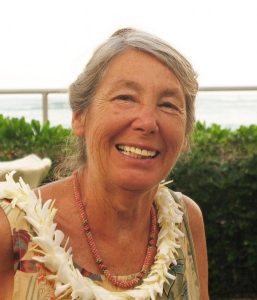The Silence of Ruin, Judith Nelson, Featured Artist’s Statement in Retrospective
While growing up my medium was not paint. It was glue and scissors making cardboard villages with sponge trees and paper strip roads. School art was pasting wallpaper samples on Kleenex boxes for family gifts, making posters, Halloween masks. Outside was for scraping ribbon paths through dirt and weeds leading to pebble and twig shelters like the miniature villages in the New York Museum of Natural History. There, in the scenic glass dioramas of stuffed bears and deer, the actual sand, stones and grasses melded magically into painted wild mountain and river scenes with lighting that mimicked sun and clouds. Press my nose on the glass, enter into that landscape. As I grew older the backwoods provided branches and stones to construct ledge shelters I could smooth out and crawl into. Rowing a skiff through ponds of tidal flats was paddling up the Amazon. Crawling under vacant houses or through drainage culverts was exploration into primal territory with rations of soda crackers. To name and follow one leaf flowing down a rain ditch was to witness threats to its passage, poised for rescue.
I came to Hawaii in 1961, the ultimate outdoors with shifting wind, rain, tides, from desert to rainforest, erasing, overgrowing, washing away. The Hawaiian petroglyphs hint their histories and heiau declare and preserve their culture whether formed by rulers or villagers.
Art is reactive. If one peels away motive and influence, what’s left is its presence. And that is what is perceived, not the reasons for it being there. I seek evidence for what I make, to make evidence of what I see.
Two things base my method, grid and symmetry. Both give structure for manipulation. By presenting my works here in sequence, there is no strict chronology. Sometimes a series allows another concept in, then continues.
It is a challenge to follow impulse with materials, creating forms and extending discovery further with each piece different enough from the last to provoke more. To see the changes that affect the work, neither naming nor isolating them.
Each image is formed with nothing loose or gestured. The process has its own momentum, barely considered. What may have begun a new series is only a minor shift. Some series were intense, some brief, some not extended further. From 700 photos of works I have chosen 100. The dates do not represent a measured progress. Viewing backwards in my own work reveals apparent moments of significance that create the next phase. I guess at those moments. Chronology varies, sometimes in stuttered sequence.
Discovering materials is impetus. Something to cut, crush, wedge. On my fifth grade rubber plantation, hand rolled plasticine gum trees sprouted green paper fronds. Fluted Ionic columns ringed Athena in my sixth grade Parthenon. Three decades later drawings of plasticine cylinders became six foot paintings of entwined tubes.
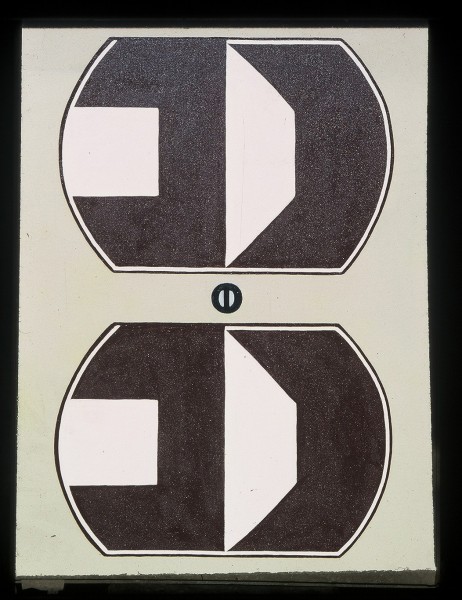 Judith Nelson, Outlet, 1962, 34X50
Judith Nelson, Outlet, 1962, 34X50
1962-68 Stylized objects, hard edged soft shapes divided and cycled
The 1962 Pop art scene heroes were prominent in media. Having a graphic arts degree, the moniker being Advertising, I was sensitized to produce eye-catching material for consumption or at least attention. Dynamic obsolescence was vilified by writers and expressed by artists in the post-war economy. Mass-produced common objects extolled as worthy art become commentary, transitioning consumer material such as food advertisements, as subject for invention. My nostalgia for toys morphed from play to Pop. Benday grids crept into the images, along with stylized shapes that pilfered the media.
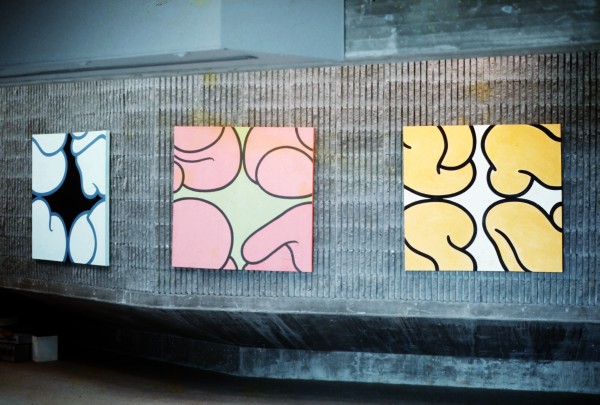 Judith Nelson, Installation, 1967
Judith Nelson, Installation, 1967
1969-1972 Diagonal divisions, overlaid volumes with transparent rotation
From Pop, single twisted tubes with wide edges were divided and quartered. The manipulation was to make one simple image crowd a surface, organizing the space into a minimal, insistent object-as-subject squeezed into hard-edged symmetry that turned the outside space into the middle.
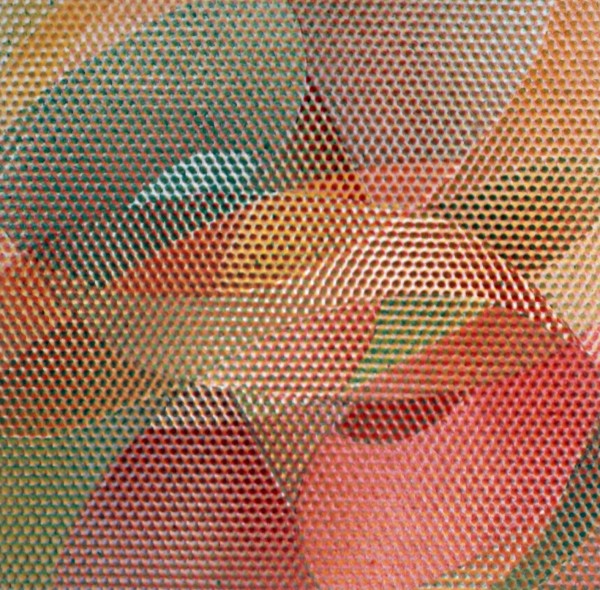 Judith Nelson, Mobius V, 1974, 18X18
Judith Nelson, Mobius V, 1974, 18X18
1973-1975 Mobius bands with layered transparency, Benday screens
Mobius paper bands loop and twist, their colors severed by overlaps so that separation and division are controlled as a visual puzzle. I superimpose the transparent image in rotation to layer the surface with color.
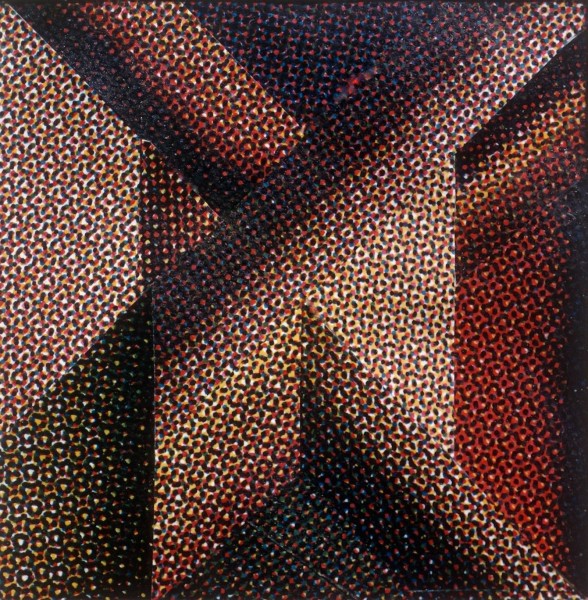 Judith Nelson, Benday VII, 1973, 4X4
Judith Nelson, Benday VII, 1973, 4X4
1976-1977 Portraits of entwined shapes
But if bands can do this, volumes can do more. Make big volumes press up behind the picture plane and feel their weight. Then the grid joins with Benday screens. When collaged in small sections, billboard dots make a color texture. To enlarge the ratio of dots to image I drilled various sized screens with holes up to one inch diameter for spray painting six foot un-primed canvas with saturated dots of shade and shadow. I used only the three primary colors, a cool red, cool yellow and cool blue to anchor the image at the surface. When these large paintings are viewed from a distance the dot colors blend into grey.
1978-1980 With geometry and grids, severed shapes crowd the surface
Angular divisions break symmetry with transparency and rotation. Planes and volumes hover or anchor, hugging the edges. Systemic patterns repeat in grids where image is sectioned from a whole. Scramble the parts in confused space so that the original grid is obscured. Large scale enhances simple imagery, giving power to the image as if it is there by circumstance and must fit the space. There are few choices to reduce inside space, one being angles. Make these planes recede or project against each other. Blink and the shapes flip into reverse. Color behavior confuses the overlaps. Impose sharp edges as each painting commands its own ether. Getting closer to layering the image, I divided what seemed to be part of the a large surface, seen as a cross-section. Tilt the axis with repeated projections into dot territory which settles into grid.
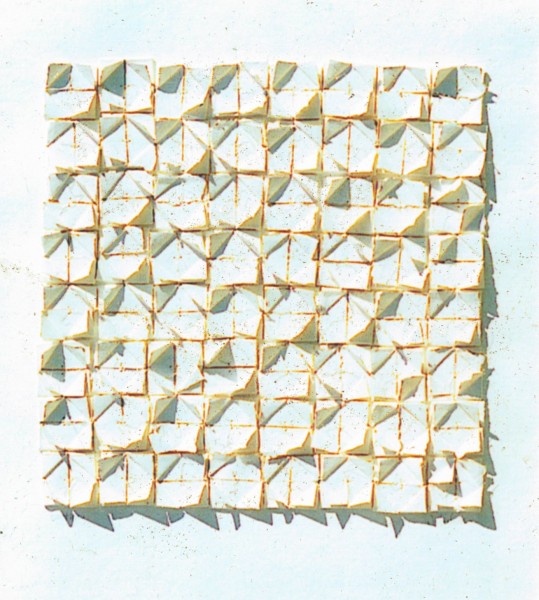 Judith Nelson, Factions, 1983, 22X26
Judith Nelson, Factions, 1983, 22X26
1981-1984 Patterns of low relief multiples, crushed and wired in sequence
Tactile surfaces crept into my work, gradually, beginning with paper shreds wired to a flat grid that softened as the manual activity of assembling loosened my application, as if they had been structured in lost time and salvaged from further distress. Time is the element of change. It wilts and rubs and disturbs original intention and those changes are its record. The object has been isolated, a piece of something from before.
1985-1986 Single-object layered paper reliefs
Painted relief paper fragments in linear sequence reveal the inside and outside colors. It becomes both geometric principal and disordered construction, the presence of grid against shape. How to absorb geometry into warped form. Crush, fold, twist its parts into a single object.
Finding is a byproduct of wander, for collecting stones and shells, pods, twigs. In my work-space, bits of bird nests, hornet nests. Washed up toys from the beach, evidence of discard and loss in our culture. Miniature dogs, pigs, seals, turtles stare at a glass box crammed with piglets, vamps, girlies and soldiers, trucks and race cars. Honor to honor waste. Threats creep in, how a seal or turtle digests a bikini doll. A race car. The shells, skulls, pods and pebbles mound alongside the box while a seal, dog, turtle and pig stare into it. I am a traveller finding significance in what is left, the history, revelation, a piece of culture or unofficial extinction with clutter as a return from chaos to a remnant of order.
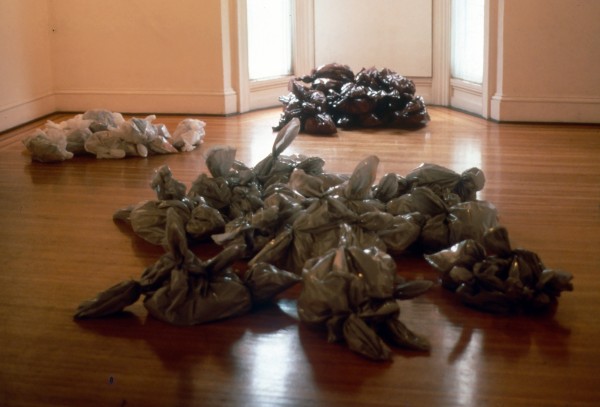 Judith Nelson, Installation III, 1989
Judith Nelson, Installation III, 1989
1987-1989 Plastic trash bags stuffed and strewn
Most contemporary waste is disposed in plastic bags that look like lost creatures. I stuffed bags with newpaper funnies, tying off the bottom for a head, then four legs. Tangled and strewn, they became litters, colonies, species. Each in position, piled up as victim of disaster or kill, disease, loss from habitat, feed, weather. A sad and quiet sight. My drawings present the bags with worried grace.
1990-1997 Paper fragments wired in sequence
Relief works are not a picture of a thing but the thing itself, its origin vague, its presence ample for study. As if from a trove of significant objects, the distressed appearance implies having suffered time. Its tactile presence brings weight in loosened shape. It may be part of a larger piece, a covering, an ornament. The grid and its geometric extensions hint of purpose, a softened organization, almost misaligned.
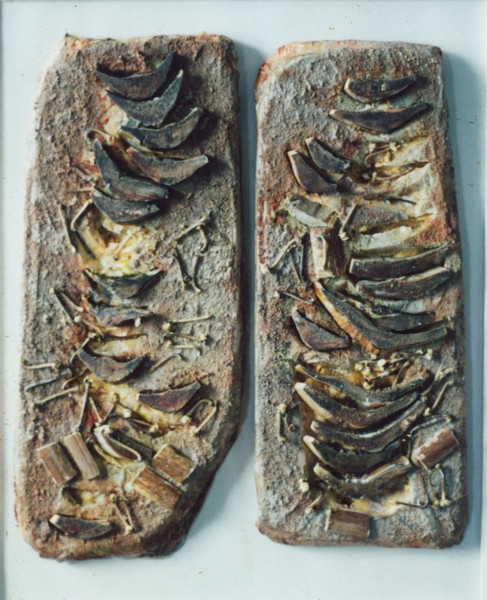 Judith Nelson, Trove Strike, 2000, 16X20
Judith Nelson, Trove Strike, 2000, 16X20
1998-2002 Pods, twigs, barks and natural debris shaped in 2 inch relief
With red dirt pigment on pod printed papers, shreds of growth mime possible natural order into new identity like a Roman vestment hung in tatters, its shape defined by what is missing. The surviving image entices interpretation by extracting the seen from the unseen whole. When the image becomes a single object the grid is fractured inside. Pods, leaves, sticks, barks integrate with the paper as if evolved within surface pattern. In the relief pieces multiple elements sag, bunch, split with an effect of imbalance.
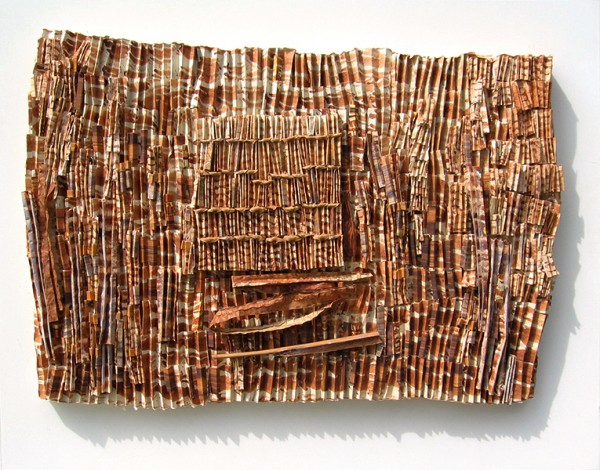 Judith Nelson, Furrow Rift, 2008, 30X36
Judith Nelson, Furrow Rift, 2008, 30X36
Since 2002…
I have lived en plein air between the Waianae Mountain range and the Mokuleia shore, a long beach from Ka’ena Point to Hale’iwa. As active contrast to ordinary seasons, this leafy canopy and vegetation is always growth in tradewind motion and sound, the rattle of fronds and leaves, shifting shadows, surf.
The detritus that I find is limp or stiff, bleached, burnt. Silent. Negligible in this radiant environment. The gum tree sheds its bark, the Ophi its shell, the Poinciana its stems, the Norfolk Pine its seeds. I make objects that site natural elements in new identities. My pieces are constructed of red dirt pigment printed with Poinciana pods and crustaceans on archival handmade papers wrapped, folded, crushed , rolled, wired. I form cobbled, barely crushed paper surfaces of repetition and overlap, with pods, stalks, leaves, seeds. Not to replace nature but to make art that mimes unstable, natural order. Each piece worries the fatigue of dissolution and becomes a remnant of its origin.
A leaf’s leaving the tree does not diminish its identity. Such a found element still holds a trace of its original form, color, texture. When natural cycles are not confused by human interference, nature repeats itself. Seeds, blossoms, barks regenerate the species through cycles and seasons that are, like tidal wash or wind piles, constellations of elements. There is serenity in detritus.
It is a challenge to use what is at hand, chosen for a dare to make the alphabet of each piece.
I alter neither shape nor color. I collect materials as discovered. I will not carve or paint a found form, because it is perfect already, character preserved.
A glimpse of a place can elicit a memory from my visual history. I re-build that recollection, imagining when where and how it inspired my memory. I shape the pieces from those places. The relief surfaces of my work bind tactile scale to visual weight, some fragile or tentative, some sturdy and thick.
Each is composed of patterns altered to echo disturbances like shifting fault lines as if what’s left is worth keeping. when the parts are preserved in such a chorus, they carry the geologic shift with slice, gouge, crunch, crumble, squeeze.
A piece can be fraction of a source, like a stone pried from a desert cliff. Or, a ritual function. A sighting that suggests larger thoughts. The buckles and overlaps, tight or haggard, extend the surface where repetition invites inspection of tension, damage, endurance, the calm of natural fatigue within the demise of fiber. I fabricate shredded niches, worn surfaces drained of pigment, with vestigial elements.
I keep looking to visibly articulate the invisible. A privilege to witness remnant and make a new remnant in its honor.
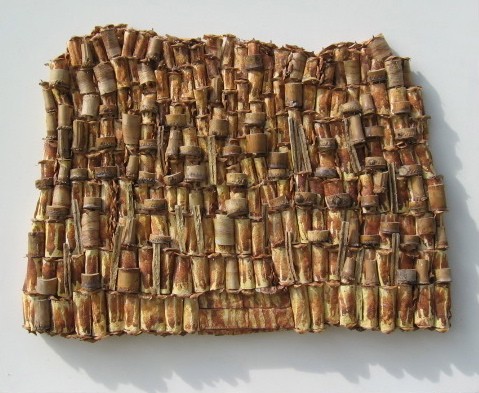 Judith Nelson, Barrow, 2007, 26X30
Judith Nelson, Barrow, 2007, 26X30

